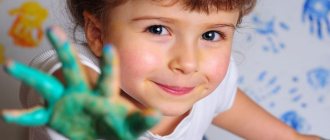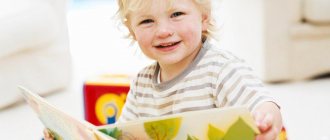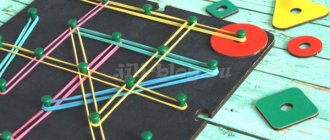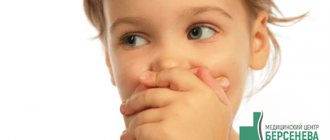Article:
According to the theory of Daniil Borisovich Elkonin (a psychologist of the Soviet period), with normal mental development, the child’s attention is mainly focused either on emotional communication or on objective activity. And for children of the fourth year of life, relationships with other people again come first, as it was at the age of birth to one year, for example. Most of all, children are now interested in role-playing games. This means that the main thing is to be able to communicate using language in order to play these games.
Features of development of children 3 years old (“Munich diagnostics”)
On the one hand, three-year-old children are constantly working motors. They cannot sit still for a long time and quickly change one type of activity to another, since attention at this age is not yet sufficiently developed. On the other hand, 3-year-old children can safely be called conservatives: they like rules, they quickly get used to the daily routine, and preferences in food and games appear. This craving for constancy is explained by the work of basic personality mechanisms that are aimed at ensuring security. What is familiar and predictable to a child causes less fear than what is new and unknown. This age is also notable for the fact that the baby becomes more independent, can defend his interests, stubbornness and whims appear.
To qualitatively assess the psychomotor, speech and communication skills of children, the “Munich Functional Developmental Diagnostics” was created in 1997 in Munich. According to it, at 3 years old a child should be able to do the following:
- Go up and down stairs;
- Jump on one and two legs;
- Catch and kick the ball;
- Do different movements at the same time (for example, shaking your head and clapping your hands);
- Step over obstacles;
- tear paper;
- Sort objects by color, size, shape;
- Build towers from cubes;
- Play games with simple rules;
- Name your gender;
- Orientate yourself in space.
At the age of 3 years, children experience a big leap in physical development. The baby can already run quickly, jump, squat, and turn his body. His movements become more precise and coordinated, and his reaction speed increases. Orientation in space also improves significantly (it is often better developed in boys than in girls of this age).
Speech development of a child at 3–4 years old: norms and features, recommended exercises
Oksana Belmas
Speech development of a child at 3–4 years old: norms and features, recommended exercises
At this age, children have already learned to think logically and draw their own conclusions about the objects they became acquainted with during play activities. The main feature of the speech development of 3-4 year old children is the ability to actively communicate with people. They speak even when it is difficult for them to pronounce sentences consisting of long structures. Difficulty pronouncing words (vowels, hissing sounds)
inherent in many children of this age, and therefore are not considered a deviation from generally accepted medical
norms . However, if there is a suspicion that speech skills are impaired , then you need to consult a pediatrician or speech therapist.
Features of speech development of a 3-4 year old child
The speech development of children 3 and 4 years old goes through certain stages of communicative communication. At first, the child learns speech with his parents, and then improves his skills in a preschool institution.
In the fourth month of life, many babies pronounce monosyllabic phrases well, and even learn to construct speech from complex sentences. It happens that it is very difficult to understand a baby, since speech functions are still poorly developed . This is especially noticeable when, while pronouncing words, a three-month-old child pauses , misses prepositions, and incorrectly puts endings or accents.
Characteristic features of the speech development of most children 3-4 years old, which are the norm , are the following indicators:
Many questions appear in the active vocabulary: why? For what? What will happen?;
boys and girls try to pronounce sentences consisting of 3-4 words;
Normally, a child’s vocabulary at age 3 is about 1,500 words, and at age four – more than 2,500 words ;
the child tries to remember and logically retell the sounds he heard, rhymes, nursery rhymes, and the speech of adults.
speech at 4 years old is constantly improving and becoming more understandable. He has already mastered enough grammar, composes phrases correctly and can even answer with a connected sentence without errors. More parts of speech and compound phrases appear. When speaking, adjectives, pronouns, prepositions and conjunctions are used. The articulation and use of verbs in numbers and persons improves noticeably.
Standards for children's speech development
The development of speech in children 3-4 years old within normal presupposes a clear understanding by mom and dad of their child . However, this indicator is purely individual. According to statistics, communication skills in most boys develop later than in girls. The delay period for personal skills can reach two to three months.
A child's speech apparatus develops as he grows up. It has its own characteristics , which depend on a number of factors - social, everyday and physiological. The first includes a good atmosphere in the family (no quarrels between parents)
and daily activities with the baby.
Physiological factors include peripheral and brain mechanisms. These speech centers are located in the cerebral cortex and store “
speech patterns ” that accumulate during the learning process.
Despite individual indicators, it is necessary to take into account generally accepted norms for assessing speech development in a 3-4 year old child . Parents' interest in ensuring that the child masters speech correctly will help avoid many obstacles in the future.
At 4 years old, a child’s speech must meet certain standards . Deviations from the norm in psychological development are possible , but not significant.
It is desirable that at this age the child should be able to:
tell about yourself (say first name, last name, residential address)
;
describe the proposed picture, retell your favorite “cartoon”
or a fairy tale;
accurately repeat words and sentences heard;
speak in lower and higher tones;
pronounce most sounds, with the exception of sonorants ( "r"
,
“l”
) and hissing (
“s”
,
“sh”
,
“sch”
);
understand well what is going on.
call the actions of pets - “the cat is lying”
,
"the dog barks"
.
If you find a discrepancy on several of the above points, seek help from your pediatrician. It is possible that the baby simply lacks parental support and attention, which is an obstacle to learning skills and abilities. If more serious disorders in delayed speech development , the doctor may prescribe a comprehensive examination for the child (psychiatrist, speech therapist, neurologist)
.
How to teach a baby to speak correctly?
Even when everything is fine with a 3-year-old child, his vocabulary needs to be constantly developed . To correct a child’s it is advisable to involve a speech therapist who will select the correct teaching method, taking into account his individual characteristics . Such trainings promote logical thinking and improve articulation.
The speech development of children at three years old proceeds in a dynamic form. During this period, it is very important to be extremely careful, not to rush to complicate classes, and soon your child’s speech development problems will be left behind .
What activities should be conducted with children at home so that they quickly master such skills? Children's speech therapists give several proven methodological recommendations :
Say all actions out loud. For example, “Anya goes for a walk outside”
,
“bring a warm blouse
,” or
. ”
Make adjustments to your speech. When communicating with your child, use different methods of intonation (loudness, intensity, prolongation)
.
Use didactic materials and speech therapy aids aimed at correcting speech disorders .
Teach your child to express his thoughts through communication. Try to gesticulate less when explaining new things.
Ask your little one to expressively voice his favorite characters ( “Teddy Bear”
,
“bunny”
,
“squirrel”
, girl
“Masha”
from the cartoon).
Strive to expand your vocabulary through tongue twisters and daily repetition of phrases. This will teach the child to speak better and remember more information.
Teach different forms of speech - from two-way dialogue to describing a specific object.
Follow the correct syntactic construction of sentences (number, case, gender)
.
During walks, give your child the opportunity to talk. Ask as many questions as possible, learn to answer subjects in detail . Give hints if he finds it difficult to answer. Reward good deeds.
A four-year-old child's speech should not be too loud or quiet. Try to teach him to talk at a certain pace and make sure that he doesn’t “jabber”
and didn’t mince words.
Fine motor skills help improve the functioning of brain centers and the pronunciation of related words. Let your child sculpt plasticine and assemble puzzles. Take him into the world of play activities, he will only benefit from this. Summarize the purpose of the objects: Paints and markers - they use them to draw, “shelves in the closet - they put children’s things on them.”
,
“from cups - they drink tea, milk and other drinks”
.
Constantly develop the organs involved in sound production (tongue, lips, facial muscles)
.
Speech defects in children can be corrected with the help of articulatory gymnastics. The main thing is not to oversaturate a 3-4 year old child with exercises .
Try to create a program in such a way as to break up classes to strengthen the articulatory apparatus over several days. Exercise with games
Everyone knows that games and toys are an interesting and exciting activity for many children. With the help of "fun"
The little preschooler trains memory, attention and learns to think logically.
During play activities, the child does not even notice how he independently develops speech , enriching it with new, more complex word forms.
It will be a plus if the parents of a 2-3 year old child help him in mastering vocabulary. A good example would be: reading books, learning poems or songs from cartoons. speech practice with other useful games and exercises , including:
Developing logic ." Arrange the pots and lids by size, from largest to smallest, let the baby learn to fold the “hats”
.
An exercise will help make him think when you need to subtract one unnecessary item from several items. For example, place 6 pencils and one felt-tip pen on the table, then ask: “What item would be extra here?”
No less useful for logical
development are activities in which the child learns to assemble construction sets, make sculptures, and combine objects by shape (rough, ribbed, smooth)
or common characteristics
(blue, red, yellow)
.
"Training your memory"
.
For example, this exercise : name with your eyes closed what is drawn on a piece of paper, and then indicate what changes have appeared in the picture (completed by one of the parents)
.
Another option is to let the child remember the toys laid out in front of him and turn away.
At this time, add one item and ask them to name it. During such activities, watch how he pronounces sounds and whether he distorts his speech. “Learning to use word forms correctly”
.
The goal is to use prepositions ( “on”
,
“under”
,
“before”
,
“about”
).
The game consists of moving objects and pronouncing their location. For example, “the cat is sitting on the table”
,
“the parrot flew into the cage”
,
“the baby fell under the chair”
.
An exercise for your child to guess objects will be useful .
From several toys, the mother chooses one and describes its characteristics, and the baby must guess what the story is about. " Exercises for the strength of voice pronunciation"
.
The goal of the game is to name objects expressively and loudly. You can train your voice power through role-playing games. Folk tales will be an excellent help here. Mom reads fairy-tale material ( “Masha and the Bear”
,
“The Frog Princess”
, changing the intonation and expressiveness of speech, then asks
the child to voice one of the characters.
Development of interactive speech . The purpose of the technique is to teach the child to build different coherent sentences. This can be achieved through direct communication with the baby, through detailed questions and answers ... It is easier for the child to build speech forms if he repeats the story after you. Ask questions more often: “what is he doing now”
,
“who says meow-meow”
,
“find the difference in the picture”
,
“what image does he see in the picture”
.
Children's speech must be developed consistently , taking into account their age characteristics and the level of general development of 3-4 year old children . All games played should not be complicated, so as not to tire or irritate the baby. It is advisable to send your child to kindergarten , where among peers, it is easier for him to develop speech skills and learn to speak correctly.
Development of fine motor skills in children 3 years old
- Drawing. At 3 years of age, drawing development is at the scribble stage. Despite the fact that the drawings can sometimes turn out to be shapeless, the child puts his own meaning into them. Three-year-olds with well-developed fine motor skills can already draw simple shapes (circle, square, lines). The drawing of a person in 3-year-old children turns out to be primitive, but it already contains a head, body, legs and arms.
- Ability to unfasten zippers and buttons. Although a 3-year-old child still cannot fasten a button or zipper himself, he has already learned how to unfasten them. Encourage your child's desire for independence, because fastening and unfastening various clasps not only perfectly develops fine motor skills, but also stimulates the development of thinking.
A three-year-old child has most hygiene skills. He knows how to wash himself, wash his hands, go to the potty, undress, and tries to eat carefully at the table.
- Toys that require developed finger motor skills. Usually at this age children like to play with small objects; puzzles, construction sets, lacing, and mosaics are used. When giving your child such toys, do not forget about safety precautions and do not leave the child unattended while playing.
- Finger games. Finger gymnastics can be a fun exercise for developing your baby’s fine motor skills. You can find ideas for finger games in the video:
Exercises to prevent speech development
A careful attitude to raising a child helps develop speech and prevent existing disorders. Parents must answer questions, describe the properties of new objects, and talk about current phenomena. The following activities help in speech development:
- comparison of objects, search for differences;
- reading fairy tales, stories, poems (you need to ask the child questions about the content of the text, study the illustrations);
- drawing the child’s attention to mistakes made;
- educational games.
The following exercises help strengthen the muscles of the face and larynx:
- clicking the tongue with stretching of the lips;
- opening and closing the mouth;
- tongue stretching;
- rolling the tongue into a tube.
Development of thinking at 3 years old
The famous psychologist J. Piaget believed that the thinking of three-year-old children is structured in such a way that they cannot look at the situation from the outside. This phenomenon is called egocentrism of thinking. In addition, children at 3 years old are not yet able to fully understand the connections between events or phenomena, so there is little logic and a lot of imagination in the child’s thinking.
It is at this age that a very important transition occurs from visual-effective to visual-figurative thinking. If in early childhood a child learned about the world through actions with objects, feeling them, tasting them, now, on the threshold of preschool age, children usually acquire the ability to act with images of objects that are preserved in their memory. A child of three years old can think about something that is not within sight. This is an extremely important step towards logical thinking.
When should you contact a speech therapist?
The following signs should be reasons to contact a specialist:
- poor vocabulary (the child pronounces no more than 20 simple syllables);
- lack of understandable names of objects in the lexicon (if baby babble is observed instead of normal speech, you should not try to fix the problem yourself);
- softening some sounds (a preschooler has difficulty pronouncing words containing the letters s, ch, ts);
- distortion of the structure of speech components;
- the presence of stuttering (multiple repetition of the first syllables).
You need to be especially careful about the speech of children learning foreign languages.
Can three-year-olds be attentive?
The ability to concentrate in 3-year-old children is low, which is why they quickly switch from one thing to another. If you force your baby to do the same thing for a long time, that is, more than 10 minutes, the nervous system will be overloaded (an external sign of which is hysterics). The attention of 3-year-old children is selective; they pay attention only to what is attractive to them.
When working with your child at home, pay attention to the baby’s condition. At this age, children get tired quickly. Therefore, all classes should be held in a relaxed playful manner. To see how you can interest a child, watch the video.
Development of memory and imagination in children 3 years old
Children of this age have the best developed emotional memory. A 3-year-old child remembers well what evokes vivid emotions and impressions in him. It's no secret that preschool children have very developed imaginations. Most of the time, three-year-old children are in the world of their fantasies. However, this also has a negative side; children can be very impressionable, which is why many fears arise that are characteristic of preschool age (fear of the dark, dogs, thunderstorms, etc.).
What mistakes can parents make when developing their child’s speech?
When raising a child, parents can make the following mistakes that prevent speech from actively developing:
- Refusal to communicate. Adults should not guess the child’s wishes without words. Excessive demands can also have an adverse effect on the development of a preschooler. Parents should not punish for incorrect pronunciation.
- Intentional distortion of syllables. Adults should not make such speech mistakes. The child remembers the spoken sounds and reproduces them later.
- Monotonous or too fast speech of the parent. Adults should use intonation, pauses, and other means of expressing emotions.
- Attempts to speed up development. Intense loads can cause fatigue and a negative attitude towards exercise.
Mental development of children at 3 years old
By the age of 3, children usually have many new skills and abilities in the field of mental abilities. A three-year-old child should be able to:
- Compare and sort objects by size, length, shape, color;
- Find the same object;
- Compose puzzles from 4 parts;
- Name primary colors and shades;
- Know poems and songs;
- Make up a story based on a familiar picture with the help of an adult;
- Know the names of some trees, dishes, furniture, animals, clothes, transport, vegetables and fruits;
- Know basic geometric shapes;
- Tell him what he did during the day.
How to formulate speech correctly
- Respond to the baby's humming and babbling, imitate his sounds, repeat them.
- Talk to your baby when you are caring for him: swaddling him, feeding him, bathing him. Talk to him throughout the day.
- Read bright, colorful books every day.
- Repeat short rhythmic poems and nursery rhymes.
- Teach your child the names of loved ones and the names of all the objects around him.
- Take your baby with you to new places, be with him in different situations.
- Draw the child's attention to various objects that make sounds (animals, birds, vehicles, etc.).
- Encourage your child to try to pronounce new words.
- “Talk” with your child new situations in which he finds himself, before, during and after the event.
- Look at the baby when you talk to him.
- Describe in detail and colorfully to your child what he hears, sees, does and feels.
- Play children's songs and fairy tales for your baby.
- When talking with your little interlocutor, do not imitate children's pronunciation; make sure that your speech is clear, expressive (but without babying), competent, simple and clear.
- Praise your child every time he initiates communication with you.
- Make sure that your child does not use sound pronunciations to indicate surrounding objects. Parents can use simplified forms of the words “give”, “am-am”, “tu-tu” when communicating with a child under one year old. This will help him get involved in the process of speech development. Then it is advisable to accompany the simplified words with the correct names. He saw the train: “Tut-tut!” - Mom responded: “Yes, the train has left.” The child is asked: “Who is this?” - he answers: “Woof-woof,” - mom explains that “woof” is said by the animal “dog.”
- Be sure to correct mistakes in your child’s speech, do it tactfully, otherwise the child may lose confidence in you.
- Enrich the child’s simplified speech: “More juice,” “Tanya wants more orange juice.”
- Choose not a narrative, but a descriptive style of communication (“There’s a crow flying” - “Look, there’s a crow flying over that house. It’s black and can croak loudly”).
- Listen to your child's answers to your questions, encourage his attempts to speak out.
- Help your child learn to listen and follow instructions through simple requests, naming a sequence of actions (preferably in a playful way): “Go to your room and bring the teddy bear.”
- For the development of a child’s speech abilities, play activities are very important, through which the child learns about the reality around him. So play with your baby!
- Include your child not only in the game, but also in real interaction with all family members. Be sure to give your little one useful tasks. Pass requests to other adults through it. Thank you for your help.
- Read every day; perhaps reading should be part of your evening bedtime ritual.
- Always listen carefully when your child speaks to you.
- Explain to your child what you think, what you plan, what you do, how you reason.
- Ask your child questions, stimulate him to think, encourage him to answer.
- Discuss with your child how he spent the day in kindergarten, how your walk together went. After playing with your child, remember the most interesting moments.
- Use visual materials. It is difficult for children to perceive words separated from an image.
- Show your child that you are listening to him carefully: nod, smile, answer his questions.
- And most importantly: support all your child’s endeavors, praise him even for minor successes.
It is important that the mother (or another adult caring for the baby), despite the workload, maintains a positive attitude towards life and communication. Therefore, take care of yourself, mothers, try to find moments of rest and switch to meeting with friends, favorite books, going to the theater. This is necessary not only for you, but also for your baby!
Speech development in three-year-old children
The speech of 3-year-old children is actively developing, kids develop an interest in language, they love to chat and talk about everything they see. Here are the main directions of speech development of three-year-old children.
- Enrichment of vocabulary;
- Phrasal speech;
- Ability to conduct dialogue (the child knows how to ask and answer questions);
- The appearance of polite words.
The speech itself of a three-year-old is far from perfect. Babies at this age usually have difficulty pronouncing hissing and sonorant sounds. At 3 years old, children often spell sentences incorrectly, confuse words, and miss words.
Learning through play
What ensures the most effective speech development of 3-4 year old children? Games, of course. The easiest and most interesting learning is guaranteed if you and your child make an alphabet coloring book. Of course, buying it is not a problem. However, do not forget that children love to make crafts on their own.
Game "Who's Talking?" interesting to many children. The mother names the sound of the animal with the desired intonation, and the child guesses. Then you must switch roles. In this way, the baby will develop speech.
The game “Where is it” develops not only speech, but also attention in the baby. Place something on the table, under a chair, near the refrigerator, next to the sofa. Now ask questions. For example: where is the cup, where did the bear go, where is the ball? There can be many such questions. The child will also learn to navigate in space.
“Edible or not?” When you are preparing dinner and cannot pay attention to your child, ask him questions. For example, if you pick up a pan, ask: “Is this edible?” Further: “And fried meat?”, “And raw chicken?” etc.
"Difference between objects." Show your baby boots and slippers. Ask how they are similar and how they are different. It can also be the following comparisons: a fur coat with a jacket, a glass with a cup, a chair with a stool, etc.
The game “Describe the Object” will help your child develop attention and memory. Point to the bed. Let the child describe it based on your questions. What is this? What is it for? What colour? Ask your child these questions about any item or product.
The above games help the child develop correct speech and the correct pronunciation of sounds. If you communicate daily with your baby in a playful way, he will soon begin to speak correctly and clearly.
Communication skills
If your child used to play alone, now the company of his peers is important to him. Children at 3 years old are usually very sociable and outgoing. According to the classification of M.I. Lisina for this age is characterized by an extra-situational-cognitive form of communication. This means that communication most often occurs against the backdrop of joint activities to get to know the world. At the same time, it is very important for a 3-year-old child to feel approval and sympathy from loved ones.
conclusions
By the age of 3, a child develops many new skills and abilities. The baby becomes more and more independent, he gradually learns to take care of himself. A three-year-old child controls his body quite well; he can maintain balance, run, jump, and play ball. The baby’s cognitive abilities also improve: thinking becomes imaginative, memory, attention, speech, and imagination develop. Communication with people reaches a new level, children become interested in communicating with peers.








